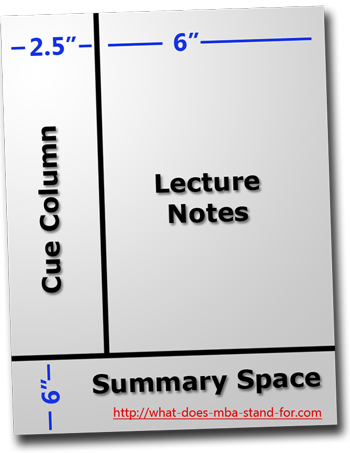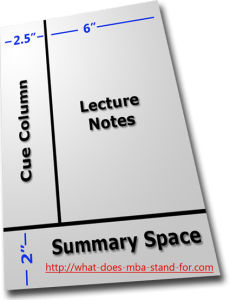
Note Taking Strategies for Your MBA Class
I’m a bit of a “taking notes” nerd, so I have a lot of note taking strategies. This has helped me to keeping a 4.0 average throughout my MBA classes. I don’t claim to be an expert on note taking techniques in other fields of study, but these tips have served me well in my MBA courses and in my Computer Engineering undergraduate degree.
Do the Required Reading before Class
If your professor has assigned you reading before class begins (and she usually has), you must actually do the reading.
I know you’re busy and you had to work late on Tuesday. And I know you’d rather do something else—but you have to read the section eventually anyway. She’s going to put the reading about forceful leadership or FIFO accounting on the midterm, and she’s going to lecture about it in class tonight. You may as well get your reading out of the way tonight so you can follow along as she goes. If you don’t understand something on page 117, you can ask about it at the appropriate point in the lecture and I guarantee you’re going to get full credit for class participation. This seems like one of the harder suggestions from my note taking strategies, but it really doesn’t have to be.
Why does this help with taking killer notes?
Because the key to good note taking is good listening. If you can follow along in class, you can listen to the teacher effectively. You won’t waste time frantically scribbling down the formula for calculating the coupon rate for a bond because you will know it is already described in depth on page 314 of the required reading.
Use Different-Colored Pens or Pencils
Sounds nerdy, huh? Many guys feel that this is a bit—ahem—effeminate. But you wanted my advice, so I give it.
Use a different colored pen for important points so that it stands out in your notes when you review them later. But trust me, on the night before your final you’ll be glad it’s easy to find your notes describing the strengths and weaknesses of focus groups as you trudge through the study guide. I personally use a pencil for the notes I take by default, with a blue colored pen (I recommend a Blue 0.5mm Pilot G2 because it writes 90% as well as a Mont Blanc, and it writes 100% as well with Mont Blanc refills).
Why does this help with taking killer notes?
Because it will make your notes usable. When you just “info dump” everything onto paper without any designation around what is important or not, your notes become a packrat’s pantry filled with information that is hard to analyze. Most of your professors give you a “study guide” before your major exams, and having an easy way to find the information you need as you prepare for the test. The less time spent finding information means you have more time to spend on sleeping.
Divide Your Page Into two Columns
On each page of your notes you should divide the page into two columns, with a section at the bottom for your summary. This is based on the Cornell Note Taking system, devised in the 1950s by Walter Paulk at Cornell University. This is one of the most famous note taking strategies in the world.
You do the majority of your note taking in the right-hand column (note-taking column) and leave the left-hand column for keywords or questions that arose during lecture. For example, as your professor drones on and on about price elasticity of demand you can record his points on the right. On the left you may write “Price Elasticity of Demand” and below that write “What products have a high P.E.o.D.?” because the professor asked the students the same question. Leave the question unanswered on the left… you can jot down the class discussion on the right.
The Cornell Note Taking system also requires you to leave two inches at the bottom of each page for your brief summary. You do this after the class has finished as your review your notes. As you decide how to summarize each page of notes it forces you to reflect and develop your own opinions of the material. This not only helps with recall, but it makes you a better critical thinker.
Why does this help with taking killer notes?
Because it forces you to take notes that are easy to navigate. When you follow this system and use a different colored pen for your key headings, your notes will be the envy of your class. Even that forty year old guy who has 34 direct reports at his company.
Date and Number the Pages of your Notes
I don’t know why I need to put this here, but you would be surprised at the number of students who couldn’t be bothered to do such a simple thing. Listen kids, it’s vital that you can put your notes in the correct order when you need to refer back to them later. You may take five pages of notes in one class alone…Good luck studying for your final when you have 34 pages of loose leaf notebook paper catching rays all throughout your living floor…with no easy way to put them back in order.
Get into the habit of putting the date and the page number of notes at the top of every page you grace with your Pilot G2. If you want to put more, like the course number and even the topic of the day, go ahead.
Why does this help with taking killer notes?
Because you can put your notes back together again when they fall out of your binder. Think it won’t happen to you? Then you’re being foolishly foolish, foolish fool.
Be as Brief as Possible
You know you can’t write as fast as your professor speaks, and you don’t want to read all his utterings later anyway. So you need to be selective in what you choose to write. Instead of writing “In the Human Equation (1998), Jeffrey Pfeffer reasons that the importance of selective hiring is that by having a large applicant pool, an organization can select the right people for their workforce” put “Pfeffer: big applicant pool = org. can hire right people.”
I know you’re already doing this to some extent, but this is more than just writing down the words that sound important. You need to listen to what Dr. Freschenschmitz is saying, put it in your own words, and then record it in a succinct way. As you get better at it you can do it without thinking. Until then, write faster or find a courtroom reporter to help you with your note taking strategies.
Why does this help with taking killer notes?
Because you will fall behind and miss important points if you’re too busy finishing up the thoughts from two slides ago. And you know you have to write down the results of the next study because your professor is published in this area. He’s gonna put it on the test.
Develop Conventions
You need to develop your own set of symbols and abbreviations to save time. They have to be your creation, too. Your conventions will probably change depending on the class too. For example, in my leadership class I found myself needing to write out the word “Leadership” a lot (go figure). So I just started writing a letter L with an arrow on top, like it was pointing up. That was my symbol for leadership. When we talked about situational leadership, I’d just write SL, but the L had the arrow hat on his head. He looked like a poor peasant “L” to you, maybe, but to me he was a proud “leadership” L.
Why does this help with taking killer notes?
Because you will be more efficient when writing your notes. You’ll have less to write and less to review. And you can have fun with the conventions you use, too.
Review Your Notes Each Week
This goes hand-in-hand with the Cornell Note Taking system described above. This is where you answer the questions you wrote in the cue column during class. And you also need to write a one or two sentence summary of your notes in the 2” tall section you created at the bottom of each page. When you spend ten minutes a week reviewing your notes you will be able to recall nearly all of your main points.
I know you’re busy with your regular life, but ten minutes a week is not anything to complain about. If it is, you shouldn’t be trying to get an MBA. Instead you should be looking for an administrative assistant.
Why does this help with taking killer notes?
Because what good are notes if you can’t remember what’s in them? The whole reason you’re taking classes is so you will learn—so why not put some effort into learning, right?
This isn’t an exhaustive list of all the note taking strategies that can help you in your quest for an “A.” But these tips are the easiest and most effective for me.
